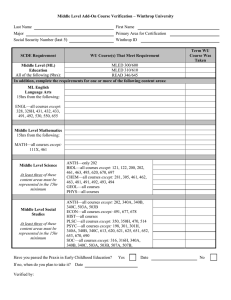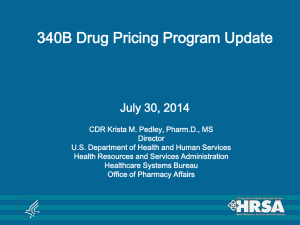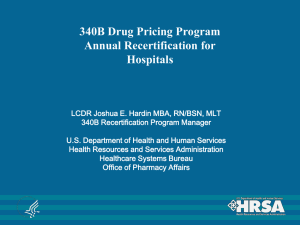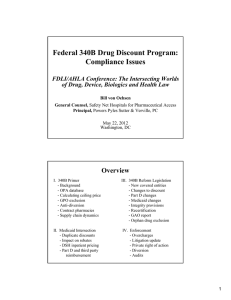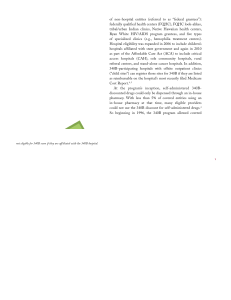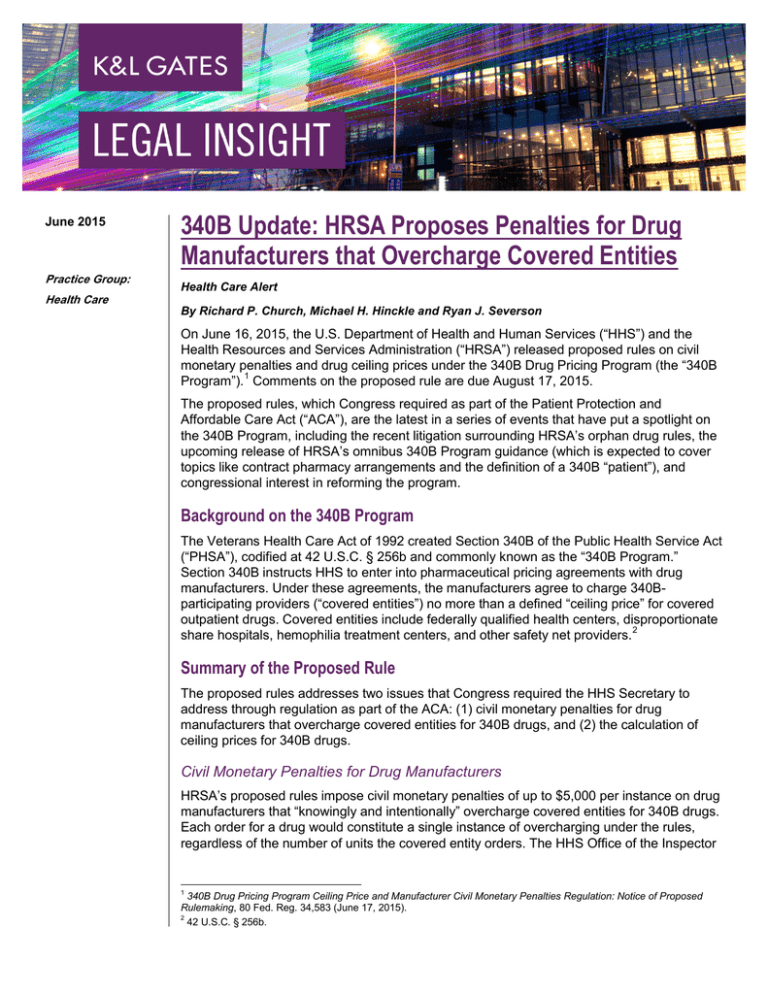
June 2015
Practice Group:
340B Update: HRSA Proposes Penalties for Drug
Manufacturers that Overcharge Covered Entities
Health Care Alert
Health Care
By Richard P. Church, Michael H. Hinckle and Ryan J. Severson
On June 16, 2015, the U.S. Department of Health and Human Services (“HHS”) and the
Health Resources and Services Administration (“HRSA”) released proposed rules on civil
monetary penalties and drug ceiling prices under the 340B Drug Pricing Program (the “340B
Program”). 1 Comments on the proposed rule are due August 17, 2015.
The proposed rules, which Congress required as part of the Patient Protection and
Affordable Care Act (“ACA”), are the latest in a series of events that have put a spotlight on
the 340B Program, including the recent litigation surrounding HRSA’s orphan drug rules, the
upcoming release of HRSA’s omnibus 340B Program guidance (which is expected to cover
topics like contract pharmacy arrangements and the definition of a 340B “patient”), and
congressional interest in reforming the program.
Background on the 340B Program
The Veterans Health Care Act of 1992 created Section 340B of the Public Health Service Act
(“PHSA”), codified at 42 U.S.C. § 256b and commonly known as the “340B Program.”
Section 340B instructs HHS to enter into pharmaceutical pricing agreements with drug
manufacturers. Under these agreements, the manufacturers agree to charge 340Bparticipating providers (“covered entities”) no more than a defined “ceiling price” for covered
outpatient drugs. Covered entities include federally qualified health centers, disproportionate
share hospitals, hemophilia treatment centers, and other safety net providers. 2
Summary of the Proposed Rule
The proposed rules addresses two issues that Congress required the HHS Secretary to
address through regulation as part of the ACA: (1) civil monetary penalties for drug
manufacturers that overcharge covered entities for 340B drugs, and (2) the calculation of
ceiling prices for 340B drugs.
Civil Monetary Penalties for Drug Manufacturers
HRSA’s proposed rules impose civil monetary penalties of up to $5,000 per instance on drug
manufacturers that “knowingly and intentionally” overcharge covered entities for 340B drugs.
Each order for a drug would constitute a single instance of overcharging under the rules,
regardless of the number of units the covered entity orders. The HHS Office of the Inspector
1
340B Drug Pricing Program Ceiling Price and Manufacturer Civil Monetary Penalties Regulation: Notice of Proposed
Rulemaking, 80 Fed. Reg. 34,583 (June 17, 2015).
2
42 U.S.C. § 256b.
340B Update: HRSA Proposes Penalties for Drug Manufacturers that
Overcharge Covered Entities
General (“OIG”) will enforce the 340B Program’s civil monetary penalties using the standards
it applies to other civil monetary penalties.3
In addition to facing civil monetary penalties, drug manufacturers that are found to have
overcharged a covered entity must continue to refund the covered entity for the overcharged
amount, in accordance with statute. In this regard, the proposed rules also impose a civil
monetary penalty for a manufacturer’s refusal to refund or issue a credit to a covered entity if
new pricing data and the re-calculation of a drug’s ceiling price reveals that a manufacturer
overcharged a covered entity in the past. 4
Under the proposed rules, drug manufacturers also bear the burden of ensuring their
distribution partners do not overcharge covered entities for 340B drugs. In particular, the
rules provide that civil monetary penalties apply to drugs ordered directly from the
manufacturer, as well as those ordered through entities like wholesalers, authorized
distributors, or agents. With that said, if a covered entity does not identify a drug as eligible
for a 340B discount at the time of purchase, the OIG will not pursue civil monetary penalties
against the manufacturer for overcharging the covered entity for the drug.5
Calculation of Ceiling Prices
The proposed rules also clarify how covered entities should calculate the “ceiling price” of
340B-eligible drugs.
The proposed rules generally codify in regulation certain policies relating to ceiling prices that
have previously appeared only in guidance (e.g., the penny pricing policy). To calculate the
ceiling price of a drug, manufacturers must subtract the drug’s Medicaid “Unit Rebate
Amount” from the drug’s “Average Manufacturer Price.” Drug manufacturers must also
provide HRSA with estimated ceiling prices for the first three quarters after a drug is first
made available for sale. Beginning with the fourth quarter after a drug is made available for
sale, the manufacturer must retroactively calculate the actual ceiling price for the first three
quarters the drug was available. If a covered entity paid more than the actual ceiling price for
the drug during the first three quarters (e.g., because the estimated ceiling price was higher
than the actual ceiling price), the covered entity is entitled to a refund or credit from the
manufacturer for those purchases. Manufacturers are required to calculate 340B ceiling
prices on a quarterly basis, and HRSA will publish each manufacturer’s ceiling prices.6
Other Changes in the Proposed Rule
In addition, the proposed rules revise several key definitions under the 340B program,
including the definitions of “ceiling price,” “covered entity,” “covered outpatient drug,” and
“manufacturer.” The rules also add new definitions to the regulations for terms such as “340B
drug,” “Average Manufacturer Price (AMP),” and “wholesaler.” 7
3
80 Fed. Reg. at 34,588.
Id.
5
Id.
6
Id.
7
80 Fed. Reg. at 34,587-88.
4
2
340B Update: HRSA Proposes Penalties for Drug Manufacturers that
Overcharge Covered Entities
Finally, the proposed rules remove the provisions that applied to “orphan drugs.” HRSA’s
340B orphan drug regulations were struck down in litigation, 8 leading the agency to
repackage and re-issue the regulations as an “Interpretive Rule.” 9
Authors:
Richard P. Church
Richard.Church@klgates.com
+1.919.466.1187
Michael H. Hinckle
Michael.Hinckle@klgates.com
+1.919.466.1115
Ryan J. Severson
Ryan.Severson@klgates.com
+1.202.778.9251
Anchorage Austin Beijing Berlin Boston Brisbane Brussels Charleston Charlotte Chicago Dallas Doha Dubai Fort Worth Frankfurt
Harrisburg Hong Kong Houston London Los Angeles Melbourne Miami Milan Moscow Newark New York Orange County Palo Alto Paris
Perth Pittsburgh Portland Raleigh Research Triangle Park San Francisco São Paulo Seattle Seoul Shanghai Singapore Spokane
Sydney Taipei Tokyo Warsaw Washington, D.C. Wilmington
K&L Gates comprises more than 2,000 lawyers globally who practice in fully integrated offices located on five
continents. The firm represents leading multinational corporations, growth and middle-market companies, capital
markets participants and entrepreneurs in every major industry group as well as public sector entities, educational
institutions, philanthropic organizations and individuals. For more information about K&L Gates or its locations,
practices and registrations, visit www.klgates.com.
This publication is for informational purposes and does not contain or convey legal advice. The information herein should not be used or relied upon in
regard to any particular facts or circumstances without first consulting a lawyer.
© 2015 K&L Gates LLP. All Rights Reserved.
8
PhRMA v. HHS, No. 13–01501 (D.D.C. May 23, 2014).
HEALTH RESOURCES & SERVS. ADMIN., U.S. DEP’T OF HEALTH & HUMAN SERVS., INTERPRETIVE RULE: IMPLEMENTATION OF
THE EXCLUSION OF ORPHAN DRUGS FOR CERTAIN COVERED ENTITIES UNDER THE 340B PROGRAM (2014),
http://www.hrsa.gov/opa/programrequirements/interpretiverule/interpretiverule.pdf.
9
3

